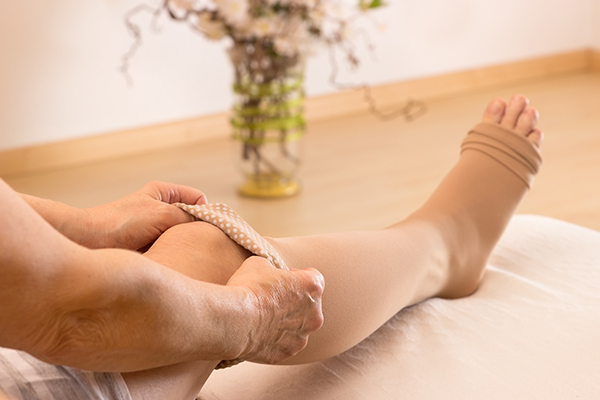Compression stockings are specially designed hosiery made to improve blood flow in the legs, prevent blood clotting, and inhibit the progression of a wide variety of venous disorders and conditions.
Adam B. Levitt, M.D., R.V.T., F.A.C.S., a board-certified vascular surgeon at Vascular Specialists of Central Florida’s Oviedo clinic, says one of the most common questions he hears from patients is, “What are compression stockings?”
Compression stockings are made up of unique elastic material that puts pressure on and around the leg. They are designed to be tighter around the ankles with gradually less pressure moving up the lower limbs toward the knees and thighs.
“The prescription stockings that we provide and recommend for you work by a graduated pressure mechanism,” says Dr. Levitt. “They are commonly referred to as 20-30 millimeters of mercury or 30-40 millimeters of mercury. These numbers are the same numbers that we use to measure pressure when we take blood pressure in your arm.”
What Are Compression Stockings Used For?

Example of compression stockings.
A vascular specialist may recommend compression stockings to help treat varicosities, spider veins, or chronic venous disease. Compression stockings can also help with:
- Alleviating achiness and heaviness in the legs
- Swelling
- Bulging of the veins during pregnancy
- Treating venous conditions such as venous insufficiency, superficial thrombophlebitis, ulcers, deep vein thrombosis, and chronic edema
Compression stockings are also employed after surgery to hinder the formation of blood clots.
How Do Compression Stockings Work?
The blood in the body travels a more or less circular route. The right side of the heart (the right atrium) pumps blood to the lungs so that it can receive fresh oxygen. After it passes through the lungs, the blood flows to the left side of the heart (the left atrium) and is then transferred to other parts of the body, to deliver much-needed oxygen to muscles, tissues and organs.
Afterward, the blood must return to the heart and lungs to be reoxygenated once again. It does so through the network of veins, and is referred to as ‘venous blood’.
When the walls and valves of the veins in the legs do not work properly, it can cause ‘pooling’ of the blood in the lower limbs, making it difficult for waste-filled blood to make it back to the heart. If left untreated, it can result in circulatory complications.
Compression stockings are designed to counteract the damaging effects of blood pooling. Unlike normal socks, they are composed of a grid of strong elastics. The stockings exert the strongest pressure at the ankles, gradually decreasing pressure intensity as one moves up the leg toward the thighs.
“They’re called graduated because as they move from the toes, they tend to be the tightest and as they go up the leg there’s a little bit less pressure,” says Dr. Levitt.
“Working with your calf muscle, the stocking is designed to help squeeze that venous blood that’s in your veins up and out, which is the primary way that we are able to move the venous blood back up toward your heart.”
The graduated compression of the stocking effectively acts like an additional layer of muscle, helping the calf muscle to gently squeeze stretched vein walls together, enabling them to close and move the blood closer to the heart and thereby restoring normal circulation.
“Think of it as a tube that’s strongest at the end that’s helping as you walk to squeeze this venous blood out back and towards your heart,” explains Dr. Levitt.
Overall, when sufficient graduated compression is applied, the diameter of major veins shrinks resulting in increased velocity and volume of blood flow and relief of pain, swelling and skin discoloration.
